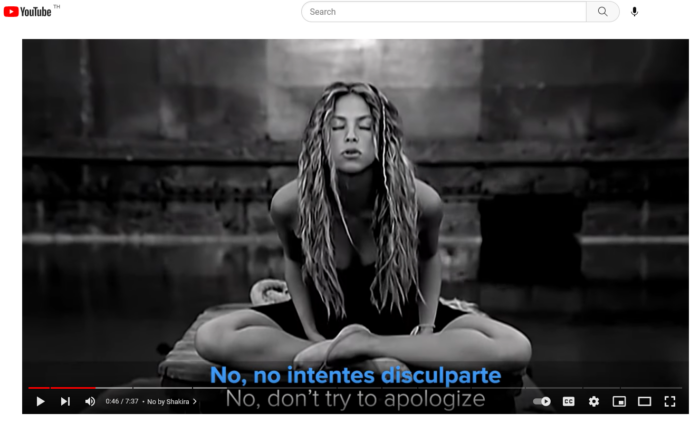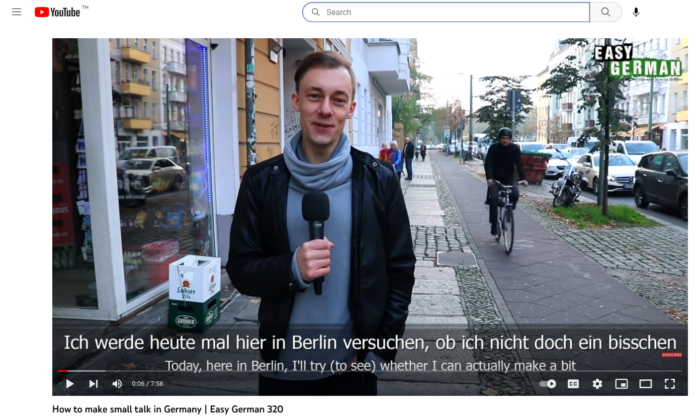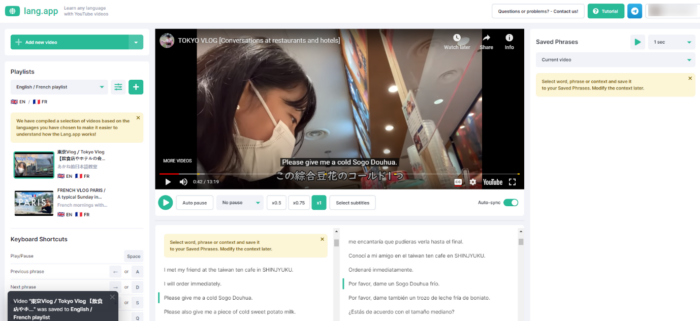7 Ways to Use Video For Language Learning
Read other articles:
Back to posts
Table of Contents
- 1 1. Subscribe to language teachers on their YouTube channels
- 2 2. “Acquire” language through videos on your favorite topics
- 3 3. Subscribe to interesting vloggers
- 4 4.Learn from songs and soundtracks on YouTube
- 5 5. Play, pause, rewind and play again
- 6 6.Guess the dialogue from short clips
- 7 7. Get AI translations of subtitles

Have you been recommended to use video for language learning but are not sure where to start?
Or maybe you’ve been stuck at the same level with a foreign language for a while and are struggling to improve?
Video is an excellent tool for people serious about learning languages and there are many reasons to incorporate video into your learning activities. Video can be personalized to tastes, activates the learning centers of the brain and provides comprehensible input in a relaxed, non-threatening environment that is conducive to “absorbing” a language.
For those aspiring to the native-speaker level, in particular, video can help you make the “final push”.
But teaching a foreign language with video is not just about putting on a movie in the classroom and testing comprehension. It’s come a long way since those days — and there are many new tools to assist teachers and students.
If you don’t have a few minutes to read this post, try out our free Chrome extension, which provides an intelligent, AI-based language tutor right at your side when learning language through YouTube videos.
Otherwise, read on for some innovative ways to use video both in the language classroom and when learning alone.
1. Subscribe to language teachers on their YouTube channels
Many foreign language teachers have set up free YouTube channels to help people learn. This video is from a popular channel from a Chinese language tutor:

Instruction varies from simply teaching vocabulary lists (unfortunately, some of the most promoted videos still focus on this uninspiring and ineffective method) to engaging videos where you learn the language from a native speaker in a variety of cultural contexts.
Some teachers offer entire language or YouTube-based courses but many also have paid online courses available that get plugs throughout the videos.
Simply type “(your target language) online courses” into the search bar on YouTube and work your way through the results until you find the type of video(s) you’re looking for. Once you’ve dived into a few, YouTube’s recommended videos should help you expand your horizons.
2. “Acquire” language through videos on your favorite topics
Some language teachers dismiss watching TV shows, movies and other videos in the target language for pleasure as “passive learning”.
However, learning a language effectively requires “compelling” input and motivation. We also know from how children learn that the most effective way to learn a language is to “acquire” it naturally through immersion.

You’re more likely to watch videos on topics you’re interested in and they’re also more likely to hold your attention. As long as they’re in the target language you’re learning, you’ll naturally absorb the language — and know when to use it in the right context.
If you’re interested in finding TV shows in a second language, simply do a Google search for the most popular TV series in that language. Then search for these shows on YouTube. You can start watching for pleasure and see how much of the language you can follow. See Tip 7 for an additional app that can help you learn quicker.
3. Subscribe to interesting vloggers
YouTube is packed with vloggers covering every topic under the sun in every language on Earth.
If you’re at a fairly advanced level with your language learning, you can search for vloggers in your target language covering topics of interest. Whether it’s learning about cryptocurrencies in Croatian, makeup in Maltese or brewing in Brazilian Portuguese, there’s probably someone covering it on YouTube.
Moderate to advanced learners can pick up new topic-specific vocab in their target language and practice their comprehension and fluency on a topic they find interesting.
This Korean vlogger has over a million subscribers!

4.Learn from songs and soundtracks on YouTube
Even though the major record companies have clamped down, YouTube remains a rich source for watching music and song videos from around the world.
Engaging, fun, and highly motivational, songs can be a great way to learn a foreign language. Lyrics stick — which is why most of us can remember the words of our favorite songs from 10 or 20 years ago. It should be no surprise to anyone that stickability is good when learning a foreign language.
Song videos practice listening skills, which are so important to acquiring language and, while phrases used in songs might need to be used sparingly in real life, it can be a fun way to learn.

Songs from different movies are a great place to start. They can spark interest in watching extracts from the full movie: again, a highly engaging and motivational way to learn a language that most students will identify with. Movie preferences may be different but the learning opportunity remains the same.
For foreign language teachers, a fun classroom game might be to play five lesser-known songs from different movies and ask students to imagine and write down what types of movie scenes they were used in. The answers can be played with the movie scene.
5. Play, pause, rewind and play again
When learning languages, it’s almost always best to watch videos in the target language that demonstrate context — rather than a teacher simply sitting at a desk.
Watching subtitled YouTube videos for pleasure is one way to learn a language but sometimes students need a little more learning intent. More advanced learners may be able to watch the videos without subtitles or with subtitles in the target language — great not only for vocabulary but for spelling and grammar.

Beginners will want subtitles in their native tongue and may need to play, pause, rewind and play again to really learn a phrase. This is fine — and one of the reasons why YouTube video is so handy for learning. Keen learners can learn a language even without a language teacher — at their own pace and on their own terms.
Learning this way enables you to “home in” on certain phrases and forms used in specific contexts and situations. It can be repetitious but if you’re learning from a movie or clip that you like, it doesn’t get boring.
6.Guess the dialogue from short clips
Many of the benefits of video learning come from listening and reading skills (input) rather than speaking or writing (output).
However, language students may improve their output too. Teachers can play short clips of video with the sound off and then ask students to guess what the characters are saying from their interactions, facial expressions and gestures. They can even create a written script.
Afterwards, the full clip can be played and any misunderstandings or omissions can be explained. Short video clips are often more effective than entire movies. They can be used to cover a wide variety of topics, situations, cultural messages and dialects.
7. Get AI translations of subtitles
Our free Chrome extension can help you learn foreign languages through captioned YouTube videos.
Combining the best of AI-based language tools as well as human experience, you simply play a YouTube video of your choice and the app runs below it. You can identify phrases that need explanation, translate everything into your native language if needed and save new vocab/phrases. There’s no need to write anything down — it’s all stored for you once you save it.
Say your first language is Spanish and you’re learning Japanese. You’ll find plenty of videos in native-speaking Japanese but it’s mainly subtitled in English. That’s no problem with this app — it translates the English subtitles into Spanish so that you can fully understand what’s going on.
It looks like this:

The app can be used with entire shows, documentaries, short clips or other engaging video content — as long as it’s captioned. This makes it an essential tool whether you’re learning a foreign language from watching videos “for pleasure” or with strong learning intent. You can learn how to install and use the app here.
Read other articles:
Back to posts
